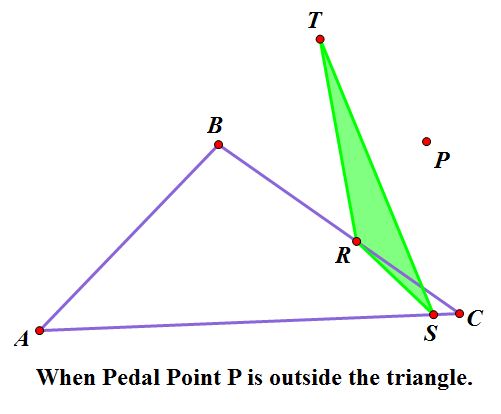

Pedal Triangle
by: Maggie Hendricks
Given a triangle ABC, any point P in the plane can be used to construct perpendicular lines to the sides of ABC (extended if necessary) that intersect with point P. The three points (R, S, and T) that are the points where these perpendicular lines through P intersect the three sides of ABC can be connected to form a new triangle. This triangle RST is known as the Pedal Triangle for the Pedal Point P. Below are some examples of Pedal Triangles for various Pedal Points P.

There are certain locations for the Pedal Point P that create unique characteristics for the Pedal Triangle. One such location is when the point P is on a side of the triangle. In order to take a look at what happens when this is the case, observe the three figures below.
Notice that when the Pedal Point P is on any one of the sides of the triangle ABC, the Pedal Point is actually one of the vertices of the Pedal Triangle. This makes sense, because the Pedal Triangle is created from the three points formed from the intersection of the perpendicular lines through P and the sides of ABC. If P is ON one of the sides of ABC, the line perpendicular to that side through it would also intersect the side at point P. Thus the intersection point of the perpendicular line would be concurrent to the point P for that particular side.
Another location for the Pedal Point P that creates unique characteristics for the Pedal Triangle is when the point P is one of the vertices of triangle ABC. To explore this case, look at the figures below.
Notice that when the Pedal Point P is concurrent with any one of the vertices of triangle ABC, the Pedal Triangle actually doesn’t exist. This is because the intersection point of the perpendicular lines through P to TWO of the three sides is concurrent with point P, and this means there are not three distinct points to determine a new triangle from. Therefore, when P is concurrent with any one of the three vertices of triangle ABC, the Pedal “Triangle” is actually just a line segment.
Click here for a GSP script tool that constructs a pedal triangle for any triangle and point P.
Click here to return to Maggie's homepage.